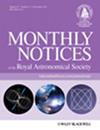关于 AGN 与 GRMHD 模拟的比较:II.M87
IF 4.7
3区 物理与天体物理
Q1 ASTRONOMY & ASTROPHYSICS
引用次数: 0
摘要
将对喷流活动星系核 M87 的地平尺度观测结果与围绕旋转黑洞的三维广义相对论流中各种耗散机制和等离子体内容的模拟结果进行了比较。通过添加指定相对论电子加正电子分布函数和相关辐射传递系数的处方,可以将从射电到 X 射线频率的同步辐射观测结果与模拟结果进行比较。我们选择了一套具有各种自旋、等离子体磁化和湍流加热的时变模拟,以及基于等分的发射预设(及其片断组合),以代表 M87 喷射/增殖流/黑洞(JAB)系统的不同可能性。然后 "观察 "模拟射流的形态、偏振和变化,并与实际观测结果进行比较,以推断支配偏振发射率的规则。我们的模型支持几种可能的自旋/发射模型/等离子体成分组合,为 M87 的喷流提供能量,事件地平线望远镜(EHT)在 230 GHz 的频率下观测到了 M87 的黑洞阴影直至光子环。在我们的参数空间中,净线性偏振和圆偏振约束有利于磁捕获盘(MAD)模型,而解析线性偏振则有利于标准和正常演化(SANE)模型。我们还表明,一些由固有圆偏振主导的 MAD 情况与非配对电子或正电子含量有着近乎线性的 V/I 依赖关系,而 SANE 偏振则表现出明显更大的正电子依赖法拉第效应--这是未来对 SANE/MAD 二分法和 EHT 等离子体含量的探测。这是系列研究中的第二项工作,也是将 "观测 "模拟方法应用于 Sgr A* 和 3C 279 中超大质量黑洞的近视界区域。本文章由计算机程序翻译,如有差异,请以英文原文为准。
On the Comparison of AGN with GRMHD Simulations: II. M87
Horizon-scale observations of the jetted active galactic nucleus M87 are compared with simulations spanning a broad range of dissipation mechanisms and plasma content in three-dimensional general relativistic flows around spinning black holes. Observations of synchrotron radiation from radio to X-ray frequencies can be compared with simulations by adding prescriptions specifying the relativistic electron-plus-positron distribution function and associated radiative transfer coefficients. A suite of time-varying simulations with various spins, plasma magnetizations and turbulent heating and equipartition-based emission prescriptions (and piecewise combinations thereof) is chosen to represent distinct possibilities for the M87 jet/accretion flow/black hole (JAB) system. Simulation jet morphology, polarization and variation are then ‘observed’ and compared with real observations to infer the rules that govern the polarized emissivity. Our models support several possible spin/emission model/plasma composition combinations supplying the jet in M87, whose black hole shadow has been observed down to the photon ring at 230 GHz by the Event Horizon Telescope (EHT). Net linear polarization and circular polarization constraints favor magnetically arrested disk (MAD) models whereas resolved linear polarization favors standard and normal evolution (SANE) in our parameter space. We also show that some MAD cases dominated by intrinsic circular polarization have near-linear V/I dependence on un-paired electron or positron content while SANE polarization exhibits markedly greater positron-dependent Faraday effects – future probes of the SANE/MAD dichotomy and plasma content with the EHT. This is the second work in a series also applying the ‘observing’ simulations methodology to near-horizon regions of supermassive black holes in Sgr A* and 3C 279.
求助全文
通过发布文献求助,成功后即可免费获取论文全文。
去求助
来源期刊

Monthly Notices of the Royal Astronomical Society
ASTRONOMY & ASTROPHYSICS-
CiteScore
9.10
自引率
37.50%
发文量
3198
审稿时长
3 months
期刊介绍:
Monthly Notices of the Royal Astronomical Society is one of the world''s leading primary research journals in astronomy and astrophysics, as well as one of the longest established. It publishes the results of original research in positional and dynamical astronomy, astrophysics, radio astronomy, cosmology, space research and the design of astronomical instruments.
 求助内容:
求助内容: 应助结果提醒方式:
应助结果提醒方式:


